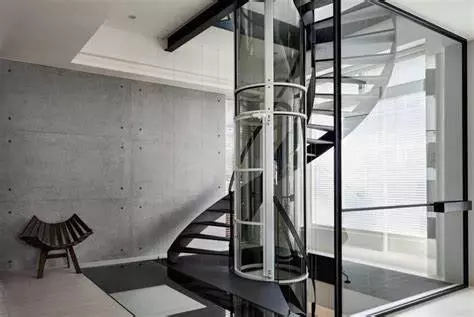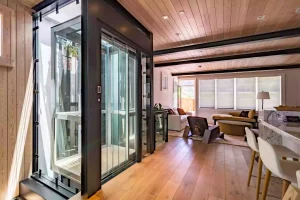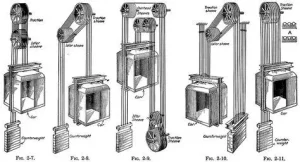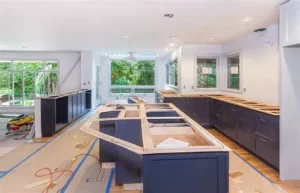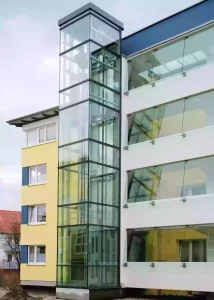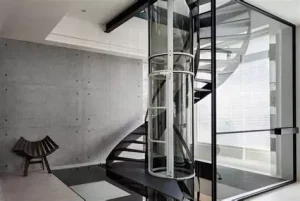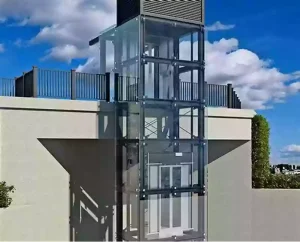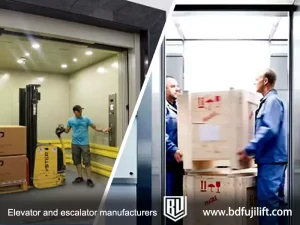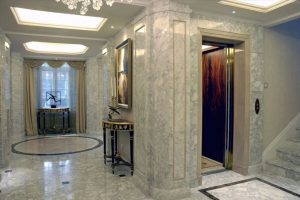If you are looking for an elevator solution for your home, read on to learn all about glass residential elevators, how they can be perfectly integrated into your home, and how to get a high-quality glass residential elevator at a low cost.
What Is a Residential Glass Elevator?
A glass residential elevator is a transparent elevator designed for home environments. Its car, shaft or both are made of tempered glass, combined with a stainless steel or aluminum alloy support structure, and driven by traction, hydraulic, or pneumatic methods. The use of glass material in residential glass elevators can not only enhance the aesthetics but also visually enlarge the space, which is particularly suitable for apartments with ample natural light.
The Difference Between Glass Residential Elevators and Traditional Residential Elevators
Compared with traditional metal-enclosed elevators, glass residential elevators pay more attention to visual interaction and design. It is no longer hidden in the corners of the home but is installed in spaces such as living rooms and stairwells with a transparent and stylish appearance to enhance the overall decoration style.
Types of Glass Residential Elevators
There are many types of glass elevators on the market, which can be distinguished by shape and installation location. For example:
Round Glass Elevator Residential
This type of elevator is usually in the shape of a panoramic cylinder, with a glass curved surface formed in one piece. The transparent glass structure not only expands the field of vision but also reduces the visual pressure, making small spaces appear brighter and more spacious. It is particularly suitable for placement in the center of a residence or in the center of a spiral staircase, with a small space occupation, and is suitable for villas with 2 to 5 floors above ground.
Square Glass Elevator Residence
The square design is more in line with the layout of most building spaces, with simple lines and greater adaptability. This type of elevator mostly uses a steel structure frame combined with tempered glass or laminated glass on four sides. It has a modern appearance and is easy to install flush with the wall. The square structure is more stable visually and is suitable for home users who want the elevator to be “hidden in the building structure”. The scope of application covers indoor atriums, wall locations and even outdoor independent shafts.
Exterior Residential Glass Elevator
If indoor space is limited, outdoor installation is a flexible option. The exterior glass elevator (exterior residential glass elevator) is usually attached to the exterior wall of the building, with an independent shaft outside. The advantage is that it hardly affects the indoor structure, but due to long-term exposure to the outdoors, we need to focus on the thermal insulation performance of the elevator cabin, anti-condensation design, and structural stability under high wind speeds during installation, especially in cold or coastal areas.
Customized Glass-Enclosed Residential Elevators
In actual use, some users want the appearance of the elevator to be consistent with the interior decoration, while others worry that transparent elevators will affect privacy, especially next to the bedroom or in the atrium of the floor. To meet these needs, customized glass-enclosed residential elevators support the adjustment of glass color, frame material, and door style, taking into account both practicality and aesthetics.
How Does a Glass Residential Elevator Work?
The glass residential elevator can move up and down, not relying on the appearance, but on the internal drive system. Different types of glass residential lifts use different drive methods, some are pulled by wire ropes, some are pushed by hydraulics, and some use air pressure to rise and fall. Next, let’s take a closer look at how these three common systems make the glass residential elevator move.
How Does a Traction Glass Elevator Work?
The core of the traction elevator is composed of a motor, a traction sheave, a wire rope, a counterweight, and a control system.
When the elevator starts, the motor drives the traction sheave to rotate, and the traction sheave drives the car at one end of the wire rope to rise and the counterweight at the other end to fall through friction, or vice versa. This method uses the principle of “lever balance”. The motor only needs to overcome part of the load to achieve labor-saving and efficient operation.
Just like the pulley system you use when pulling up the curtains, when one side is pulled, the other side naturally falls back. It is this dynamic balance mechanism that makes the traction elevator run smoothly and consumes less energy, especially suitable for multi-story residential buildings.
How Does a Hydraulic Glass Elevator Work?
The hydraulic elevator consists of a hydraulic pump station, a hydraulic cylinder, a piston, and a control system, and the structure is relatively simple.
When the elevator starts, the pump station begins to pressurize, injects hydraulic oil into the cylinder, pushes the piston up, and the car rises with it; when it descends, the oil pressure is released, the piston slowly falls back, and the car also follows.
This process follows the basic principles of fluid mechanics, just like water flows from high to low. Hydraulic elevators run smoothly and are suitable for low-rise residential buildings, but the cylinder may have aging or oil leakage after long-term use.

How Does a Pneumatic Glass Elevator Work?
Pneumatic elevators (also known as vacuum elevators) are mainly composed of sealed cylinders, elevator cabins, top exhaust devices, and air control valves.
When it is necessary to rise, the top exhaust device will quickly extract the air above the cylinder, causing the internal air pressure to decrease, so that the elevator cabin will slowly rise under the push of atmospheric pressure. When descending, the system adjusts the intake balance pressure and uses the cabin’s own weight to complete a smooth descent.
The whole principle is similar to when we usually drink beverages with a straw, the mouth sucks out the air, and the liquid rises naturally. The air pressure elevator does not require a shaft, occupies a small area, and is quick to install. It is an ideal choice for small apartments or renovated spaces.
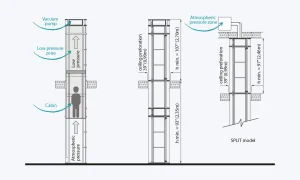
What Are the Advantages of Glass Residential Elevators?
Glass residential elevators are not just a tool for going up and down the stairs. Many families choose it and pay more attention to its additional benefits in terms of vision, space, and property value. Let’s take a closer look at the actual benefits of this type of elevator.
Enhanced Sense of Space
Glass residential elevators are transparent on all sides and will not block the view like traditional elevators. Even if installed in a small apartment, it will not make the space look cramped, but make the room look more open.
Optimize Indoor Lighting
Glass elevators can transmit light like windows and bring natural light into the room during the day. Especially when installed near stairwells or skylights, many users find that they use fewer lights during the day, saving a lot of electricity bills.
Improve Property Value
In the United States, single-family homes with glass residential elevators usually sell for higher prices when resold. Data shows that the average premium for such homes is between 8% and 12%, which is particularly popular with high-end buyers.
What Are the Disadvantages of Glass Residential Elevators?
No elevator is “perfect”. Although glass residential elevators are beautiful, there are some problems that cannot be ignored during the actual installation and use.
1. The Cost Is Higher Than That of Traditional Elevators
Glass home elevators do not use ordinary glass, but high-strength tempered or laminated glass, which is much more expensive than metal cover plates. In addition, glass elevators require higher installation accuracy, and the construction difficulty and labor costs will also increase accordingly. In summary, its overall cost will be 20% to 30% higher than that of traditional home elevators.
2. Cleanliness and Privacy
Residential glass elevators have a transparent appearance, but they are more likely to leave water stains, fingerprints, or dust, especially when there are children at home or they are used frequently. They need to be wiped and maintained regularly to maintain their beauty. For elevators installed next to the living room or bedroom, the transparent structure may make some users feel exposed. At this time, we can use local frosted glass or metal shielding to solve the problem.
Which Buildings Are Suitable for Glass Residential Elevators?
Not every house is suitable for installing glass elevators. It has certain requirements for building structure, spatial layout, and installation conditions. If the conditions match, glass elevators can not only improve the convenience of life but also become a design highlight in the home. Let’s find out what type of house is most suitable for installing glass elevators.
Villa / Duplex Apartment
2 to 4-story single-family houses or duplex structures are the “golden partners” of glass elevators. This type of residential building has low floors, but strong vertical movement lines. Common installation methods include: staircase central axis through-type, elevator embedded in the atrium, or window layout. When designed properly, the elevator itself can become a “work of art” in the space.
Renovation of Old Houses
When renovating old houses, glass elevators are often used as a combination of “function + aesthetics”. It not only solves the problem of inconvenience in going up and down stairs but also relieves the sense of spatial oppression and improves lighting conditions. It is especially suitable for upgrading traditional houses to barrier-free houses.
Those With Sufficient Exterior Wall Space
If it is impossible to reserve an elevator shaft indoors or the movement line is inconvenient, some houses can choose to install glass elevators on the exterior walls of the building. The premise is that the exterior wall structure is stable enough and the foundation can be reinforced. This solution is suitable for customers who want to add to old buildings or keep the complete indoor pattern, especially in houses with large spaces in the backyard, side walls, etc.
Design Drawings and Schematic Diagrams of Glass Residential Elevators
When many customers consider installing glass residential elevators, their first reaction is “Can my house be installed?” In fact, different structures can be adapted to glass residential elevators through different layout methods. The key lies in how to embed space, maintain transparency, and ensure safety. Below are two typical residential glass elevator installation schematic layouts, which will help you quickly understand common installation methods and applicable situations.
Schematic Diagram of Circular Installation of Residential Glass Elevator in the Middle of the Spiral Staircase
If the home has a circular staircase, spiral staircase, or central spiral staircase layout, the elevator can be installed vertically through the center axis of the staircase. This method does not take up extra space and is visually very coordinated. The elevator looks like it is “floating” in the center of the staircase. It is usually recommended to use a round glass elevator (round glass elevator residential), which has a small diameter and compact structure and is suitable for homes within 3 floors.
Schematic Diagram of Wall-Mounted Residential Glass Elevator Installation
If the stairs are concentrated on one side or the room is long, the elevator can also be installed close to the load-bearing wall, using an L-shaped or semi-frame structure for support. This type of layout is suitable for symmetrical floor structures, which are convenient for entering the car from multiple directions, retaining the glass appearance without destroying the wall’s load-bearing structure, and is particularly suitable for old buildings or elevator installation projects.
How Much Does It Cost to Install a Residential Glass Elevator?
How much does it cost to install a residential glass elevator? There is no standard answer to this question, but we can give a reasonable budget range based on current market data.
Cost Range of Glass Residential Elevators
Currently, the average price of glass residential elevators in the United States is between $35,000 and $65,000, equivalent to about RMB 250,000 to 470,000.
This range is mainly affected by the following factors:
-
Whether a new elevator shaft needs to be built or renovated
-
Drive system type (traction > air pressure > hydraulic)
-
Door opening method (manual, automatic, single-sided door opening, or through-type)
If it involves high-end design, custom size, or special glass material, the price will continue to rise.
Daily Maintenance and Service Life of Glass Residential Elevators
In addition to the initial purchase cost, maintenance frequency, and service life will also affect the total cost of a glass elevator. If not properly maintained, even high-priced elevators may fail within a few years, which will increase later expenses.
The core maintenance of an elevator includes the following three parts:
-
Track and guide system: regular lubrication to avoid abnormal noise or jamming during operation;
-
Electrical control system: check button response, power module, door control switch to prevent sudden failure;
-
Sealing structure and glass cleaning: check whether the sealing strip is aging, clean the car glass, and prevent dust and rain from eroding parts.
It is recommended to maintain 1 to 2 times a year, and the cost is usually in the range of several hundred dollars.
In daily use, try to avoid slamming the door, hitting hard objects, or letting rain enter the elevator cabin, which can also extend the service life.
Frequently Asked Questions About Glass Residential Elevators
When many people first come into contact with glass residential elevators, they will have some practical but easily overlooked questions, such as whether they can be installed in old houses. Is it unsafe? Here we give concise answers to these common questions:
Can Glass Residential Elevators Be Installed in Old Houses?
It can be installed, but the premise is that professionals must evaluate whether the building structure has sufficient load-bearing capacity. If the house does not have a reserved well, it may be necessary to reinforce the wall or foundation or choose an external installation solution to avoid damaging the original structure.
Will There Be Problems With Residential Glass Elevators on Rainy Days?
If it is installed outdoors, the elevator must use a special sealing frame, top cover, and drainage system. As long as these designs are in place, they can be used as usual on rainy days without leakage or short circuit.
Is the Glass of a Glass Residential Elevator Easy to Break?
Formal glass residential elevators use tempered glass or laminated glass, which has an impact strength of 3 to 5 times that of ordinary glass and meets the European EN81 elevator safety standard. Even if it is accidentally broken, it will break at an obtuse angle and will not splash and hurt people, with a high safety factor.


